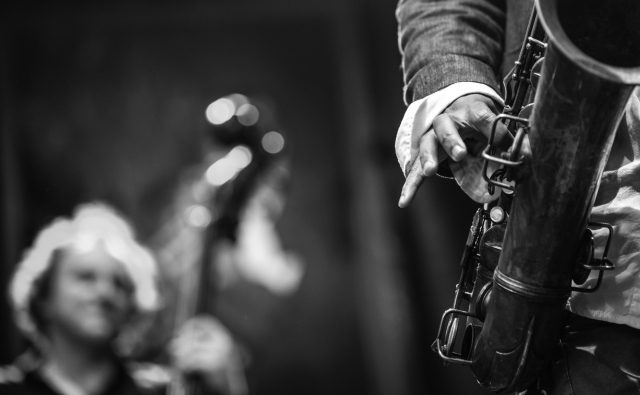Exploring the brain of jazz musicians

Improvisation is a hallmark of jazz music, arguably its most salient feature. When they improvise, musicians compose and play simultaneously, one of the most notorious examples of spontaneous creativity. What happens in the brain during improvisation is largely a mystery, but studying it may help us gain some insight on the basis that underlie the creative process.
Most of the literature on music and emotions focuses on the way we perceive music and how it spurs our emotions. Few works address the converse issue, that is how the brain works to actually express emotions through music.
There is a good reason for this: to study which areas of the brain respond to specific tasks, neurologists use functional magnetic resonance scanners, which measure blood flow changes in the brain. Scanners are narrow and noisy, and subjects have to lie down, thus restraining the types of experiments that can be done.
But these technical problems didn’t put off Charles Limb and his team at the Johns Hopkins School of Medicine, who were interested in peeking inside the brain of jazz musicians while they improvise.
No problem
In their latest work on this topic1, Limb’s group wanted to test two hypothesis:
The first one was that the patterns of activation of the brain regions would be different when the improvisation was spurred by emotions. And since listening to music can be pleasant regardless of if it is happy or sad music, their second hypothesis was that improvisation brought up both by positive and negative emotions would stimulate reward areas of the brain (i.e. those involved in desire and hedonism) in a similar way.
To test these ideas they recruited professional jazz pianists and asked them to play inside the scanner in response to emotions evoked by photographs of an actress representing positive, negative of ambiguous emotions.
To overcome the technical issues above-mentioned, the researchers came up with some innovative solutions. First, they contacted an engineer who designed a miniature, non-magnetic, thirty-five key keyboard to rest on the subjects’ lap. The piano sound was routed back to the subjects via in-ear electrostatic earphones, so they could hear what they played. Also, a system of mirrors was installed within the scanner to allow the subjects to see the keyboard. Studying creativity requires creative ideas.
Body and soul
Although there are no strict rules in music, in Western culture music major scales are commonly associated with happier moods, while minor scales have a sadder, darker flavour. Consistently, when the subjects were asked to play music evoked by positive emotions, they mostly used major scales, whereas negative emotions were expressed with minor scales and ambiguous emotions used both modes indistinctly. These observations confirmed that the experimental setting was reliable and the photographs evoked the correct emotions.
Functional magnetic resonance measurements allowed to monitor which parts of the brain were activated or deactivated in each situation. Regardless of the emotion underlying each improvisation, the act of improvising per se had some perceptible effects in the brain. These included the activation of the Broca’s area, a region involved in speech production, and the deactivation of the dorsolateral prefrontal cortex, a trait that is associated with entering into the so-called “flow state”, a mental condition in which individuals become completely absorbed by the task they are doing.
As hypothesized by the researchers, improvisations driven by emotions were handled by the brain differently than non-emotional improvisation, meaning that the functional network involved in creativity can be modulated by the emotional intent. The patterns of activation and deactivation of brain regions were also different to those normally observed when people simply listen to music.
However, to their surprise, positive and negative improvisations had different impacts in the areas of the brain involved in reward and flow state. The deactivation of the prefrontal cortex was extremely pronounced during positive improvisations when compared to negative or ambiguous emotions, indicating deeper flow states. Negative improvisations, on the other hand, activated a reward region called substantia nigra, which the authors think could imply an increased “visceral awareness”. These rewarding aspects could also relate with the ability of music to express emotions without any real-life costs, maintaining a degree of distance from the art, an interpretation that is consistent with activation of brain areas related to cognitive control and self-monitoring during negative improvisations. The implications are that expressing happiness or sadness through music can be pleasurable for different reasons and be mediated by different neurobiological systems.
The picture that emerges from these studies is that the neuronal networks used during improvisation are incredible complex and context-dependent. Creativity uses all available resources from the brain, from reward centres to language-processing areas, and combines them in different ways.
While certainly more research is needed to begin to unravel the neuronal basis of how artistic expression is articulated by the brain, this work shows that the best way to tackle creativity is using creative approaches.
References
- McPherson MJ, Barrett FS, Lopez-Gonzalez M, Jiradejvong P, Limb CJ. (2016) Emotional Intent Modulates The Neural Substrates Of Creativity: An fMRI Study of Emotionally Targeted Improvisation in Jazz Musicians. Sci Rep 6:18460. doi: 10.1038/srep18460. ↩
2 comments
[…] Se ha estudiado bastante lo que pasa en el encéfalo mientras se escucha música. No tanto lo que ocurre mientras se crea, lo que podría ser muy útil para saber cómo funciona la creatividad. Ignacio Amigo en Exploring the […]
[…] Se ha estudiado bastante lo que pasa en el encéfalo mientras se escucha música. No tanto lo que ocurre mientras se crea, lo que podría ser muy útil para saber cómo funciona la creatividad. Ignacio Amigo en Exploring the […]